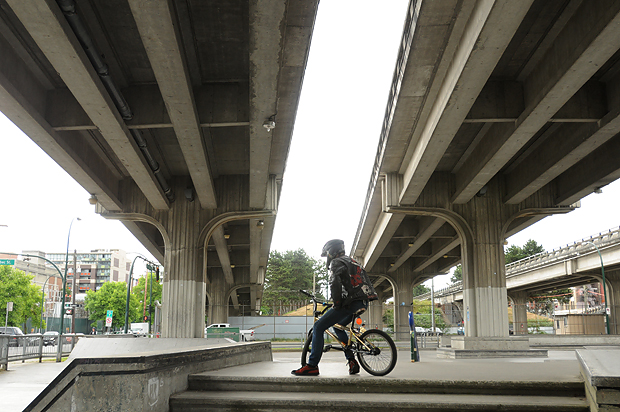City staff wants two more years of study
Mike Howell
Van. Courier

A city staff report released Wednesday says demolishing the Georgia and Dunsmuir viaducts would cost up to $55 million and climb to more than $130 million once creating a new street network and other upgrades are calculated in the project. Photograph by: Dan Toulgoet , Vancouver Courier.
It would cost up to $55 million to demolish the Georgia and Dunsmuir viaducts and replace them with a new link from Georgia Street to existing roads in Northeast False Creek.
The tab for such a project climbs to more than $130 million when costs are calculated to modify existing streets, parks, utilities, build more parks and conduct soil remediation on what were former industrial lands.
City staff outlined the costs in a report released Wednesday that strongly suggests the 1970s era hulking structures be demolished to open up the area for parkland, housing and better connections between neighbourhoods.
But the report stopped short of recommending city council give the green light to take down the viaducts until more planning work is done on the feasibility of the demolition and the future of the eastern core of the city.
“The issues under study, related to the potential removal of the viaducts, are complex and there is a significant amount of work still to be done before a final report is brought before council,” said the report authored by Brian Jackson, the city’s head planner.
Approximately $1 million has been spent to date on the planning and engineering work related to the removal of the viaducts. But city staff wants two more years and $2.4 million to spend on a “work program” to examine the bigger picture of what removing the viaducts will mean for the neighbourhood and surrounding communities.
There’s also the problem of what to do about the 43,000 vehicles per day that use the viaducts, which are well-used links in and out of downtown for the movement of goods.
The report notes, however, that as time passes, the cost of removing the viaducts will become “more and more challenging,” given the need for temporary roads and deconstruction sites to facilitate the removal of the viaducts.
Retaining the viaducts would cost up to $120 million, if rehabilitation, maintenance and eventual replacement costs are factored in over 40 years, the report said.
If the viaducts were demolished, it would free up 10 acres of land worth up to $110 million. Although staff’s desire is to have the land devoted for public open space, affordable housing and other public uses, the report notes some of the land could be sold for development.
The report also points out removal of the viaducts has “significant positive impacts” to Concord Pacific’s lands, which are adjacent to the viaducts and would require an agreement with the city to accommodate a new street network.
“For Concord, this will produce new development parcels which will need to consider tower placement and density, park configuration and programming and soils contamination,” the report said.
The suggestion to demolish the viaducts continues an emerging trend in North American cities. The report mentions Boston, at great expense, eliminated its elevated waterfront freeway and connected that city’s downtown to the waterfront.
In San Francisco, politicians there elected to tear down the Embarcadero freeway and reconnect several of that city’s neighbourhoods.
“In every city’s evolution, there are rare opportunities to take bold city-building steps to advance the city’s goals and liveability, or correct a past planning wrong,” the staff report said. “The potential removal of the viaducts provides an opportunity for the City of Vancouver to do both.”
With city staff wanting at least two years to plan for the removal of the viaducts, the next opportunity for council to make a final decision on the viaducts’ fate may not come before a new council is elected in the fall of 2014.
If the council of the day decides the viaducts should be demolished, it could take up to six years before they come down.
© Copyright (c) Vancouver Courier
